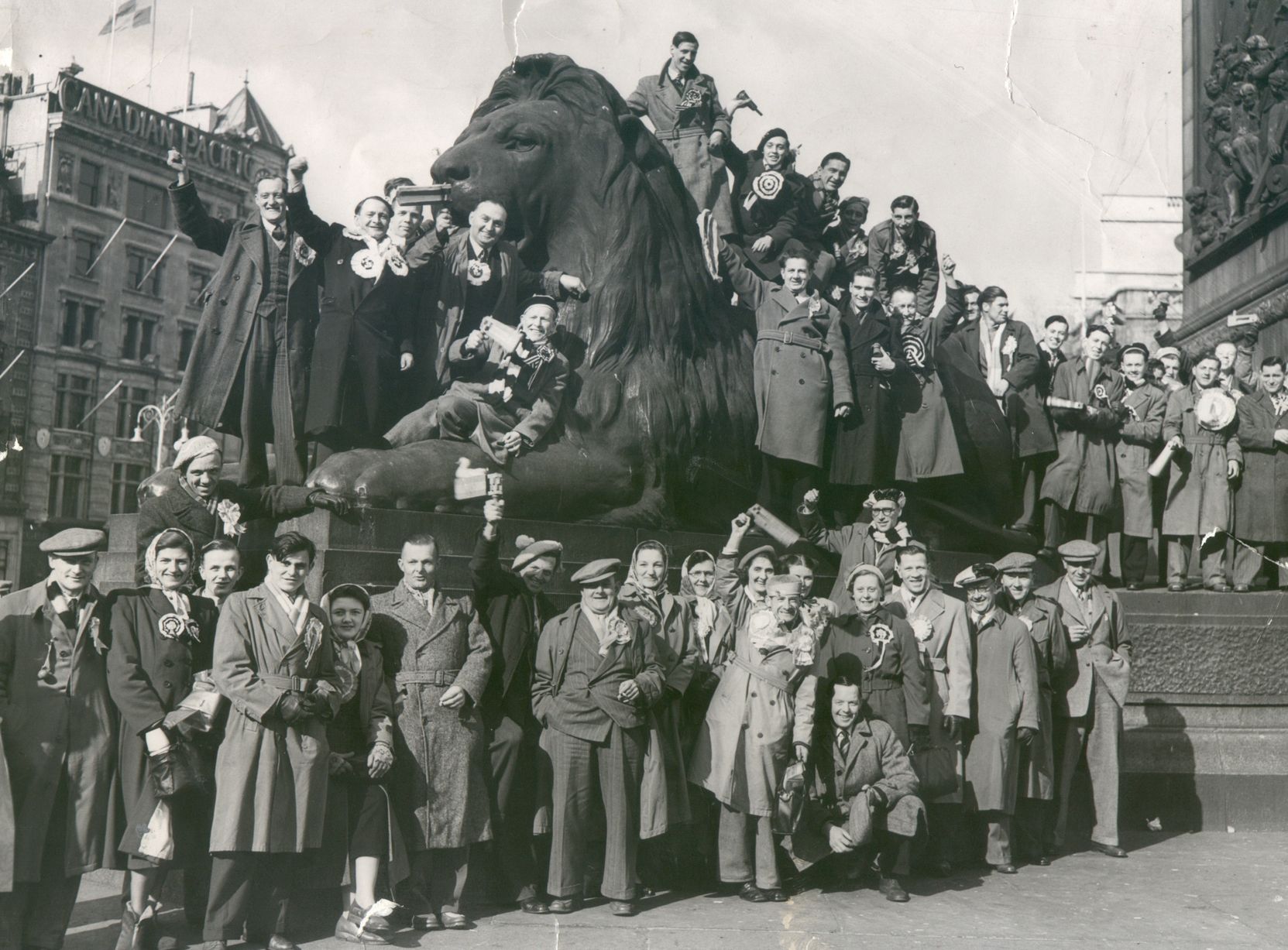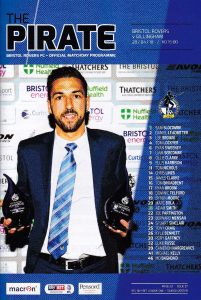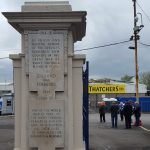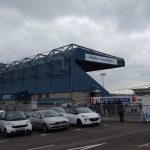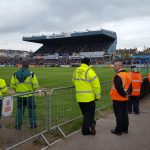Bristol Rovers 1 Gillingham 1
League 1
Saturday 28 April 2018
The context
A long overdue trip. John and I had been putting off coming here because of Rovers’ proposed new ground near the University of Western England at Frenchay; this scheme, however, now seemed dead and buried following a quarrel with prospective Memorial Ground purchasers Sainsbury’s.
The history
Eastville Stadium – Rovers’ home between 1897 and 1986 – was two miles away from their present ground. IKEA now occupies its site. I knew Eastville from an early age, because my great-aunt lived nearby; tall floodlight pylons backdropped early-1970s family Sunday teas. This area had suffered heavy bombing during World War II, and underwent further needless destruction when the M32’s elevated carriageway sliced through Bristol’s northern suburbs.
The famous Thirteen Arches didn’t survive. This much-loved viaduct once connected the Clifton Extension Railway with a line – closed by Beeching – that ran through Fishponds and Staple Hill to Mangotsfield. Post-war decline had already proved disastrous for local railway infrastructure. Fast trains to Wales no longer stopped at the previously bustling junction at Stapleton Road, and its goods yard closed in 1965.
Stapleton Road station once handled 350 trains each day. Brunel’s Extension Railway allowed passengers from southern Bristol to connect with cross-Severn ferries from New Passage; later, when a tunnel was built beneath the river, London expresses serving Cardiff and Swansea stopped here rather than using Temple Meads. By 1939 the station had three substantial platforms and four through lines.
Many fans used it too. Rovers were established Second Division members between 1953-62 and 1974-1981; Eastville’s record gate of 38,472 saw their 1960 FA Cup tie with Preston in 1960, while more than 34,000 turned up against Arsenal in 1967. League Cup games against Stoke (1971) and Manchester United (1972) attracted similarly packed crowds. “Eastville was hostile and passionate”, recalls one Cardiff fan. “The football specials would be crammed full.”
This was the era of Alan Warboys and Bruce Bannister. Rovers’ twin strikers – respectively nicknamed “Smash” and “Grab” in acknowledgement of very different playing styles – scored 123 goals between them, forty during the 1973-74 Third Division promotion season. Their lasting fame became assured on 1 December 1973 when Rovers – enjoying a 27-game unbeaten run – won 8-2 away from home against Brian Clough’s Brighton team, Bannister getting three and Warboys four.
Generations of working-class Bristolians spent hard-earned cash at Eastville. Its elliptical bowl also hosted greyhound racing, speedway, stock cars, athletics, cricket, concerts, American football and (on one notable occasion) the Harlem Globetrotters. Circuses and fairs regularly set up on the huge cinder car park, and club anthem Goodnight Irene was first sung after a 1950s firework display. Cash-strapped Rovers had by then sold their freehold interest to the greyhound company. That rash move would come back to haunt them.
Few travelling supporters recall the place with any great affection. It wasn’t in Bristol’s most salubrious neighbourhood, and assorted rougharse pubs – Black Swan, White Swan, Station Tavern, Sugar Loaf, Fox, Three Blackbirds – dotted every route to the ground. After running this gauntlet they huddled on bleak open terracing, directly beneath four lanes of motorway, where even a slight wind would blow dust clouds off the greyhound track straight into their faces.
Home fans are more nostalgic. They mourn flowerbeds decorating open space behind each goal, noxious fumes that drifted from Stapleton gasworks (Rovers’ popular nickname remains The Gas) and their beloved Tote End. This name celebrated the roof-mounted totaliser used to display dog race results: beneath stood a grim, dark terrace much favoured by 70s bovver boys. Severe perimeter fencing made it seem even more intimidating.
Things began to unravel in 1980 when the South Stand burned down. This held all Rovers’ playing equipment and offices. No-one knew how the fire began, but – combined with a bitter ongoing dispute over rents – it ultimately made Eastville unviable for football. They considered groundsharing at Ashton Gate (to widespread dismay from both sets of fans), but their newly-insolvent neighbours wanted even more money than Eastville’s owners had done.
And so Rovers cohabited with Bath City. Their ten-year exile – borrowing non-League facilities most kindly described as basic – lasted until 1996. Twerton Park’s sloping pitch, tight touchlines and uneven terraces made it even less attractive to visitors than Eastville had been, particularly when Gerry Francis unexpectedly led his workmanlike team back to the Second Division in 1991.
You can see some recent pictures of Twerton Park here .
The journey
A trip South at least avoided any further alarm among Keele’s elderly residents. Instead we were back at our regular Cannock car-share, where the locals must by now recognise – and perhaps even like – us. Once in Bristol I parked among quiet streets near some spatula-like floodlights. These actually belonged to Gloucestershire’s county cricket ground, but hey.
The ground
- pillar
- parking
The Memorial Stadium was originally built by Bristol Rugby Club. They opened it in 1921 to commemorate rugby players killed during World War I. Rovers initially took up residence as tenants, later buying out their erstwhile landlord when they got into financial problems. Sound familiar? The rugby club have now left and share Ashton Gate following that ground’s recent redevelopment.
At first glance everything looks rather half-finished. That oval-ball heritage means unusually wide touchlines, and Rovers had little incentive to fund improvements while the Frenchay project remained viable. Terracing abounds, with half open and the rest fronted by intrusive pillars. Fans therefore face Hobson’s choice between a decent view or staying dry; games usually draw capacity crowds, so many people arrive early to get their favourite spot.
- sold
- stripy
- seated
We had invested in stand tickets. “Stand” might have been overdoing things slightly; most seats sell out months in advance, but Rovers have done their best with several of those temporary structures – made out of stripily-canvassed scaffolding – that you see at country shows and the like. Ours was OK so far as such things go. You could see all four corner flags, and in fairness reasonable prices did reflect the spartan facilities on offer. Eastville’s legacy surely lives on.
Flesh and wine
Down at the Wellington punters sat out front with pints. They had plenty of ales to choose from and meat pies could be bought over the bar. Filming for The Young Ones took place near here; it seemed pre-match boozers were eager to create similarly anarchic vibes. Fans of both clubs got happily shitfaced together, and one dressed as a dog barked loudly while debagging another who wore full Gillingham kit. Once in every lifetime.
The game
- camera
- corner
- crowd
This was Rovers’ last home match. Gillingham – aided by some indulgent refereeing – nonetheless approached it in combative mood. Not much really happened until Dom Telford headed home from his own rebounded shot. Cue scenes of relieved celebration; the goal encouraged Gillingham to momentarily abandon their cautious tactics, and half-hearted defending gifted Elliot List’s stoppage time equaliser. Goodnight Irene.
Teams and goals
Bristol Rovers: Slocombe, J Clarke, Lockyer, Craig, Brown, Bennett, Lines, Sercombe, Moore (Broom 74), Nicholls (Telford 59), Harrison (Gaffney 60). Unused subs: Broadbent, Bola, Smith, Mensah.
Gillingham: Holy, O’Neill, Zakuani, Ehmer, Garmston, Byrne, Wagstaff, Reilly, Martin, Parker (Wilkinson 68), Eaves (List 75). Unused subs: Hessenthaler, Ogilvie, Nugent, Hadler, Nasseri.
Goals: Bristol Rovers: Telford 86. Gillingham: List 93.
Attendance: 9715

